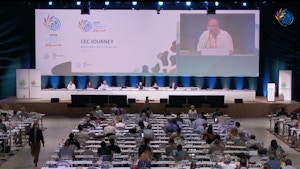Leading scientific experts have proposed a slew of transformative measures to reduce the risk of pandemics, that will cost a fraction of Covid-19’s multitrillion-dollar impact on the global economy.
To continue reading, subscribe to Eco‑Business.
There's something for everyone. We offer a range of subscription plans.
- Access our stories and receive our Insights Weekly newsletter with the free EB Member plan.
- Unlock unlimited access to our content and archive with EB Circle.
- Publish your content with EB Premium.
Escape from the “pandemic era” will require policies geared towards prevention, instead of containment and control, they said.
Green bonds aimed at biodiversity conservation and pandemic risk reduction, taxes on certain livestock production, and incorporating emerging disease risk into the impact assessments of major development and land-use projects were some measures suggested in a new report issued on Thursday (29 October).
The report, by the Intergovernmental Platform on Biodiversity and Ecosystem Services (IPBES), comes amid a resurgence of Covid-19 in many European countries and the United States. IPBES is an independent intergovernmental body with 137 member states. Although it is not a United Nations (UN) body, its secreteriat services are provided by the UN Environment Programme.
Experts proposed reducing or removing species from wildlife trade that have been identified as having high risk of disease emergence. Wildlife farming, trade and consumption have led to diseases such as Covid-19—where early cases were reported from a wholesale market in Wuhan, China—and Severe Acute Respiratory Syndrome (Sars).
Covid-19 has killed nearly 1.2 million people and caused economic upheaval since it emerged late last year. It cost the global economy an estimated US$8 trillion to $16 trillion by July, and could cost the US US$16 trillion by the end of next year.
Pandemics cause widespread suffering and are likely to cause more than a trillion dollars in economic damage a year, the IPBES report noted. In contrast, the tab for prevention strategies are estimated to cost US$40 billion to $58 billion annually.
“Without preventative strategies, pandemics will emerge more often, spread more rapidly, kill more people, and affect the global economy with more devastating impact than ever before,” the authors said.
The IPBES report was the result of a workshop held in July for experts to review scientific evidence on the origin and impact of Covid-19 and other pandemics, as well as prevention using a “one health” approach that integrates human and animal health, as well as the environment.
Many more undiscovered viruses
More than five new diseases emerge in people every year that have the potential to become pandemic, the report noted. Meanwhile, an estimated 1.7 million undiscovered viruses exist in mammals and birds, of which 540,000 to 850,000 could infect humans.
To reduce pandemic risk, policymakers must address land-use change caused by agricultural expansion and urbanisation, as well as the wildlife trade, the report said.
The trade in mammals and birds carries a higher disease risk because many pathogens with pandemic potential reside in mammals (bats, rodents and primates, in particular), some birds (in particular water birds), as well as livestock such as pigs, camels and poultry.
Besides reducing or removing species in the wildlife trade with high risk of disease emergence, governments should test the efficacy of market clean-out days, increased cold chain capacity, and biosecurity and sanitation in markets. They should also conduct disease surveillance of traded wildlife, and of wildlife hunters, farmers, and traders.
Where there is a clear link to high pandemic risk, taxes or levies on meat consumption and production can be considered, the report said. There can also be incentives for companies to avoid land-use change that has high pandemic risk, or products that come from unsustainable trade or wildlife farming.
Research so far shows that there are emerging infectious disease hotspots, said Professor David Hayman of Massey University in New Zealand.
“These hotspots are areas where there’s intersection of high biodiversity, high human population growth and high livestock density,” said the infectious disease ecologist at a media conference for the report’s launch. “We are using new tools, new narratives to try and identify where those locations are, and what might tip them (into becoming) hotspots.”
Budgets, green bonds and the private sector
The world must strike a balance between production and demand, and the private sector plays an important role in reducing pandemic risk, said Dr Carlos Zambrana-Torrelio, associate vice-president for conservation and health at EcoHealth Alliance, an environmental health non-profit.
“We can talk with the industry to say, ‘You can do some development to produce meat and food for global demand, but do it this way, or (develop to this extent) that’s not going to become a risk to humanity’,” he said.
Dr Peter Daszak, who chaired the July workshop and is president of EcoHealth Alliance, noted that the livestock industry is “huge, growing, globalised and very profitable”. But consumers must also change their lifestyles, such as by reining in overconsumption of meat, he said.
Governments should integrate the economic cost of pandemics into their budgets, the experts said. When the externalities of future pandemics are integrated into budgets, this is likely to result in increased resources to protect biodiversity.
New investment tools like green corporate or sovereign bonds and blended finance could help mobilise resources for biodiversity conservation and pandemic risk reduction. These bonds could link the cost of the debt to progress in protecting biodiversity and reducing pandemic risk, the report said.
And as zoonotic outbreaks can threaten the stability of the financial system, central banks could target and buy debt that supports biodiversity conservation and reduction of pandemic risk as part of their objectives, it stated.












